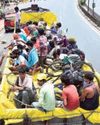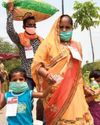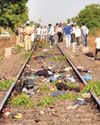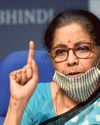
UTTAR PRADESH
Anxiety over arrivals
VENKITESH RAMAKRISHNAN
“Even though Uttar Pradesh is the most populous State in the country, the number of COVID-19 cases are comparatively lower than in other States, especially when we look at the population to positive cases ratio.” This is the refrain of senior officials of the State government, including the Health Department’s Principal Secretary, Amit Mohan Prasad, in their briefings on the COVID-19 relief activities in Uttar Pradesh. Officials have also stressed that an important reason for this situation is widespread screening and surveillance. Talking to the media on May 5, Prasad said: “So far 50,193 teams have been involved in the surveillance work and have covered more than 43.56 lakh houses and screened at least 2.16 crore people.”
However, the Union Health Ministry’s tabulation on the evening of May 5 showed that deaths due to COVID-19 in Uttar Pradesh had shot up by 71 percentage points over the preceding seven days. A similar tabulation for active COVID-19 cases for the same period showed that the rate of increase in Uttar Pradesh was just 16 percentage points, much lower than the national average of 45 percentage points. Talking about these figures, a senior Union Health Ministry official pointed out, off the record, that the message for the Uttar Pradesh government, and indeed for all governments, was that screening and surveillance needed to be followed up with good clinical care. He was also of the view that the manner in which the public health care system in Kerala had rallied around to provide adequate clinical care to those identified as “active” was the definitive model for the other States to follow.
この記事は FRONTLINE の May 22, 2020 版に掲載されています。
7 日間の Magzter GOLD 無料トライアルを開始して、何千もの厳選されたプレミアム ストーリー、9,000 以上の雑誌や新聞にアクセスしてください。
すでに購読者です ? サインイン
この記事は FRONTLINE の May 22, 2020 版に掲載されています。
7 日間の Magzter GOLD 無料トライアルを開始して、何千もの厳選されたプレミアム ストーリー、9,000 以上の雑誌や新聞にアクセスしてください。
すでに購読者です? サインイン

How Not To Handle An Epidemic
The lockdowns were meant to buy time to put in place appropriate health measures and contain the coronavirus’ spread, but they have failed to achieve the objective and heaped immense misery on the marginalised sections of society. India is still in the exponential phase of the COVID-19 infection and community transmission is a reality that the government refuses to accept.

Tragedy on foot
As the COVID-19-induced lockdown cuts the ground beneath their feet in Tamil Nadu, thousands of migrant workers are trudging along the highway to the relative safety of their upcountry homes.

Sarpanchs as game changers
Odisha manages to keep COVID-19 well under control because of the strong participation of panchayati raj institutions and the community at the grass-roots level under the leadership of Chief Minister Naveen Patnaik.

Scapegoating China
As the COVID-19 death rate spikes and the economy tanks in the United States, Donald Trump and his advisers target China and the World Health Organisation with an eye to winning the forthcoming presidential election.

New worries
Kerala’s measured approach to the pandemic and lockdown has yielded results. But it still has to grapple with their huge economic impact on its economy, which it feels the Centre’s special financial relief package does little to alleviate.
No love lost for labour
Taking advantage of the lockdown and the inability of workers to organise protests, many State governments introduce sweeping changes to labour laws to the detriment of workers on the pretext of reviving production and boosting the economy.

Capital's Malthusian moment
In a world that needs substantial reorienting of production and distribution, Indian capital is resorting to a militant form of moribund neoliberalism to overcome its current crisis. In this pursuit of profit, it is ready and willing to throw into mortal peril millions whom it adjudicates as not worth their means—an admixture of social Darwinism born of capital’s avarice and brutalism spawned by Hindutva. .

Understanding migration
When governments and their plans are found to be blatantly wanting in addressing reverse migration, exercises such as the Ekta Parishad’s survey of migrant workers throughout India can be useful to work out creative long-lasting solutions.

Waiting for Jabalpur moment
The Supreme Court’s role in ensuring executive accountability during the ongoing lockdown leaves much to be desired. Standing in shining contrast is the record of some High Courts.

An empty package
The Modi regime, which has been unable to control the COVID-19 infection, restore economic activity and provide relief to millions exposed to starvation, trains its sights on Indian democracy, making use of the panic generated by fear and a lockdown that forecloses paths of resistance.